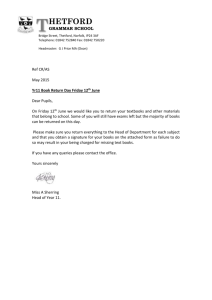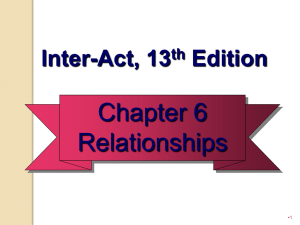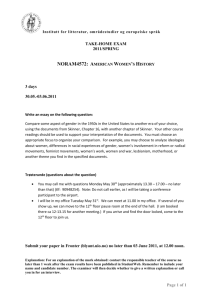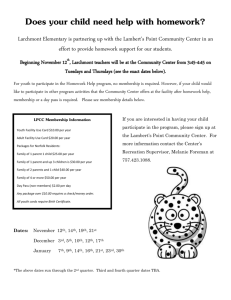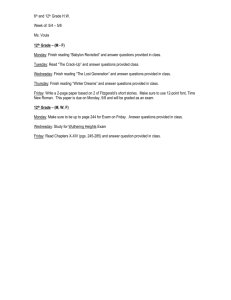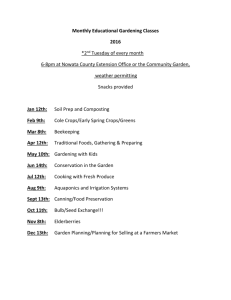File
advertisement
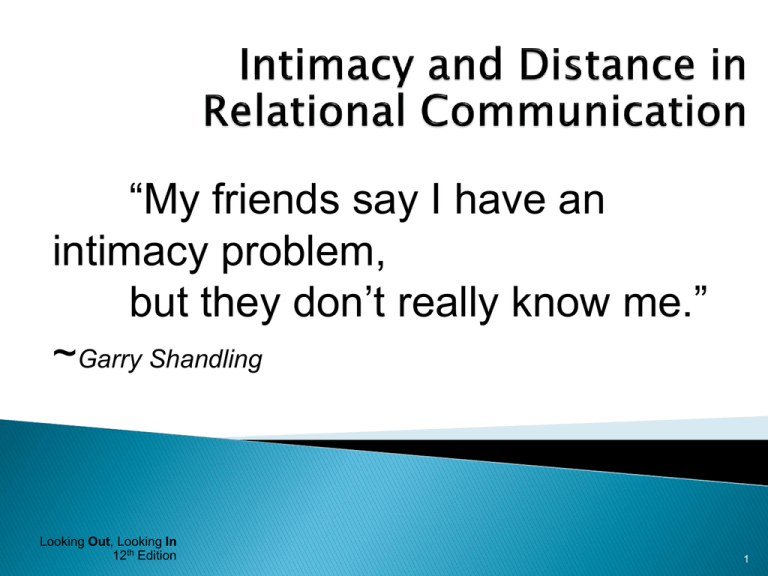
“My friends say I have an intimacy problem, but they don’t really know me.” ~Garry Shandling Looking Out, Looking In 12th Edition 1 Dimensions of Intimacy •Intimacy: state of close union, contact, association or acquaintance •Dimensions of Intimacy •Physical •Intellectual •Emotional •Shared Activities Looking Out, Looking In 12th Edition 2 Masculine and Feminine •Most research does show females are better at maintaining intimate relationships. •The gender role one adopts proves to be more significant in how a person will react. •Generalizations do not apply to every person. Looking Out, Looking In 12th Edition 3 Cultural Influence •The notions of public and private behavior have changed. •Self-disclosure is high, especially in North American culture •Cultural Impact on Intimacy •Individualistic •Collectivistic Looking Out, Looking In 12th Edition 4 Computer-Mediated •CMC can now enhance the level of emotional closeness. •Intimacy may develop more frequently online. •Anonymity and freedom of expression •Not all online relationships are intimate. •Some are very impersonal. Looking Out, Looking In 12th Edition 5 The Limits of Intimacy •It is impossible to have a close relationship with everyone. •At times, less intimate relationships can be fulfilling. •Remember: you can have a successful relationship without meeting a high level of intimacy. Looking Out, Looking In 12th Edition 6 Degrees of Self-Disclosure •Breadth of Information •Depth of Information •Depending on the interaction of the two, a relationship will be more or less casual or intimate. FIGURE 9.2 Page 306 Looking Out, Looking In 12th Edition 7 Degrees of Self-Disclosure •Clichés •Virtually the opposite of self-disclosure •“Hey, how are you doing?” •Facts •Not all facts qualify as self-disclosure. •Disclosing important information suggests a level of trust. Looking Out, Looking In 12th Edition 8 Degrees of Self-Disclosure •Opinions •Opinions usually reveal more about a person than facts. •Every time you offer your opinion, you’re giving more information about yourself. •Feelings •Feelings are different from opinions. •Too much personal information can be unappealing. Looking Out, Looking In 12th Edition 9 Joharri Model FIGURE 9.3 Page 308 FIGURE 9.4 Page 308 FIGURE 9.5 Page 308 Looking Out, Looking In 12th Edition FIGURE 9.6 Page 309 10 Benefits •Catharsis •Sometimes we disclose information to get it off our chests. •Reciprocity •There is no guarantee that your self-disclosure will be reciprocal. •If it is, it is not always going to be equal. •It takes time. Looking Out, Looking In 12th Edition 11 Benefits •Self-Clarification •Talking the problem out with others •Occurs with hairdressers, bartenders, even good friends •Self-Validation •Disclosing information while looking for listener’s agreement •This is a very important step in the “coming out” process. Looking Out, Looking In 12th Edition 12 Benefits •Identity Management •Revealing personal information to make ourselves more attractive •A salesperson might say, “. . I’ll be honest with you.” •Relationship Maintenance and Enhancement •Social Influence •Revealing personal information may increase your level of control. •We offer information about ourselves to learn more about others. Looking Out, Looking In 12th Edition 13 Risks •Rejection •The fear of disapproval is powerful. •Some real dangers in revealing personal information: •A: I’m starting to think of you as more than a friend. •B: I think we should stop seeing one another. •Negative Impression •Disclosure can lead to a negative impression. Looking Out, Looking In 12th Edition 14 Risks •Relational Satisfaction decrease •Loss of Influence •Confessing a weakness may lead to someone’s using it against you. •Hurting the Other Person •What you reveal may hurt the person you’re revealing it to. Looking Out, Looking In 12th Edition 15 Guidelines for Self-Disclosure •Do you have a moral obligation to disclose? •Is the other person important to you? •Are the amount and type of disclosure appropriate? •Is the risk reasonable for disclosing? Looking Out, Looking In 12th Edition 16 Guidelines for Self-Disclosure •Is the disclosure relevant to the situation at hand? •Will the effect be constructive? •Is the disclosure clear and understandable? •Is the self-disclosure reciprocated? Looking Out, Looking In 12th Edition 17 Lying •Silence •Simply not disclosing •Sometimes silence can be in the best interest of both parties. •Lying •The benevolent lie •Nonmalicious or even helpful to the person it’s told to •The average lie rate is three fibs for every ten minutes of conversation. Looking Out, Looking In 12th Edition 18 Lying •Reasons for Lying •To save face •To avoid tension or conflict •To guide social interaction •To expand or reduce relationships •To gain power Looking Out, Looking In 12th Edition 19 Equivocating •When faced with lying, communicators can equivocate. •Equivocal Communication leaves room for interpretation: •“That is so interesting!” good or bad interesting? •“I’ll meet you at the apartment,” could refer to more than one place. •“It’s really unusual – one of a kind,” could refer to different emotions. Looking Out, Looking In 12th Edition 20 Hinting •Hints are more direct than equivocal statements. •The success of a hint depends on the receiver’s ability to detect the underlying emotion. •If the risk of direct communication seems to high, you can always drop a hint. Looking Out, Looking In 12th Edition 21 The Ethics of Evasion •Reasons not to challenge statements that are untrue: •When we expect others to tell fibs •When the lie is mutually advantageous •When a lie helps us avoid embarrassment •When a lie helps us to avoid confronting an unpleasant truth •When we have asked the other person to lie Looking Out, Looking In 12th Edition 22 Chapter Summary •Intimacy in Relationships •Self-Disclosure in Relationships •Alternatives to Self-Disclosure Looking Out, Looking In 12th Edition 23
